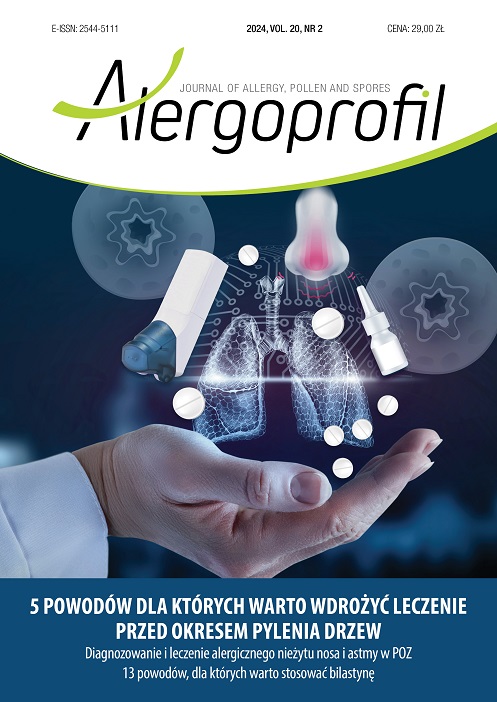13 reasons to use bilastine Review article
Main Article Content
Abstract
Antihistamines are the first line agents used for treatment of allergic reactions. Bilastine is a latest non-sedating histamine H1-receptor antagonist developed for the treatment of allergic rhinoconjunctivitis and urticaria. Bilastine has a similar efficacy to other second-generation H1-receptor. Bilastine is not metabolized in the human body and does not require dose adjustment in liver and/or kidney disorders. All these features make the drug a good alternative to other antihistamines.
Downloads
Article Details
Copyright: © Medical Education sp. z o.o. This is an Open Access article distributed under the terms of the Attribution-NonCommercial 4.0 International (CC BY-NC 4.0). License (https://creativecommons.org/licenses/by-nc/4.0/), allowing third parties to copy and redistribute the material in any medium or format and to remix, transform, and build upon the material, provided the original work is properly cited and states its license.
Address reprint requests to: Medical Education, Marcin Kuźma (marcin.kuzma@mededu.pl)
References
2. Bousquet J, Schunemann HJ, Hellings PW et al. MACVIA Clinical decision algorithm in adolescents and adults with allergic rhinitis. J Allergy Clin Immunol. 2016; 138: 367-74e2.
3. Samoliński B, Krzych-Falta E, Piekarska B et al. ARIA 2019 – zintegrowana opieka w alergicznym nieżycie nosa – Polska. Alergologia Polska – Polish Journal of Allergology. 2019; 6(4): 111-26. http://doi.org/10.5114/pja.2019.91214.
4. Emeryk A, Rapiejko P, Janeczek K. Bilastyna na tle innych leków przeciwhistaminowych II generacji. In: Emeryk A. Bilastyna w chorobach alergicznych u dzieci. Medical Education, Warszawa 2019.
5. Rapiejko P, Lipiec A. Bilastyna w leczeniu alergicznego nieżytu nosa. Postep Derm Alergol. 2014; XXXI(suppl 2): s16-s27.
6. Sadaba B, Azanza JR, Gomez-Guiu A et al. Critical appraisal of bilastine for the treatment of allergic rhinoconjunctivitis and urticaria. Ther Clin Risk Manag. 2013; 9: 197-205.
7. Corcostegui R, Labeaga L, Innerárity A et al. In vivo pharmacological characterisation of bilastine, a potent and selective histamine H1 receptor antagonist. Drugs. 2006; 7: 219-31.
8. Pawliczak R. Bezpieczeństwo nowych leków przeciwhistaminowych. Terapia. 2012; 4: 60-6.
9. Simons FE, Simons KJ. Histamine and H1-antihistamines: celebrating a century of progress. J Allergy Clin Immunol. 2011; 128: 1139-50.
10. Jutel M, Solarewicz-Madejek K. Bilastyna – nowy lek przeciwhistaminowy. Alergia. 2011; 3: 37-9.
11. Horak F, Zieglmayer P, Zieglmayer R et al. The effects of bilastine compared with cetirizine, fexofenadine, and placebo on allergen-induced nasal and ocular symptoms in patients exposed to aeroallergen in the Vienna Challenge Chamber. Inflamm Res. 2010; 59(5): 391-8.
12. Kuna P, Bachert C, Nowacki Z et al. Bilastine International Working Group: Efficacy and safety of bilastine 20 mg compared with cetirizine 10 mg and placebo for the symptomatic treatment of seasonal allergic rhinitis: a randomized, double-blind, parallel-group study. Clin Exp Allergy. 2009; 39(9): 1338-47.
13. Bachert C, Kuna P, Sanquer F et al. Comparison of the efficacy and safety of bilastine 20 mg vs desloratadine 5 mg in seasonal allergic rhinitis patients. Allergy. 2009; 64: 158-65.
14. Sastre J, Mullol J, Valero A et al.; Bilastine Study Group: Efficacy and safety of bilastine 20 mg compared with cetirizine 10 mg and placebo in the treatment of perennial allergic rhinitis. Curr Med Res Opin. 2012; 28: 121-30.
15. Antonijoan R, Coimbra J, García-Gea C et al. Comparative efficacy of bilastine, desloratadine and rupatadine in the suppression of wheal and flare response induced by intradermal histamine in healthy volunteers. Curr Med Res Opin. 2017; 33(1): 129‐36. http://doi.org/10.1080/03007995.2016.1240665.
16. Jauregizar N, de la Fuente L, Lucero ML et al. Pharmacokinetic- pharmacodynamic modelling of the antihistaminic (H1) effect of bilastine. Clin Pharmacokinet. 2009; 48: 543-54.
17. Hanley MJ, Cancalon P, Widmer WW et al. The effect of grapefruit juice on drug disposition. Exp Opin Drug Metab Toxicol. 2011; 7: 267-86.
18. Scaglione F. Safety profile of bilastine: 2nd generation H1-antihistamines. Eur Rev Med Pharmacol Sci. 2012; 16(14): 1999-2005.
19. Woroń J, Lorkowska-Zawicka B, Dobrowolska E et al. Praktyczne aspekty interakcji leków w farmakoterapii otolaryngologicznej, czyli 7 grzechów głównych leczenia farmakologicznego w praktyce lekarza otolaryngologa. Otolaryngol Pol. 2016; 70(4): 1-9. http://doi.org/10.5604/00306657.1205273.
20. Woroń J. Niekorzystne interakcje leków przeciwhistaminowych – dlaczego mają tak istotne znaczenie praktyczne, jakie są pomiędzy nimi różnice? Terapia. 2015; 6: 39-43.
21. Graff C, Struijk JJ, Kanters JK et al. Effects of bilastine on T-wave morphology and the QTc interval: a randomized, double-blind, placebo-controlled, thorough QTc study. Clin Drug Investig. 2012; 32: 339-51.
22. Okubo K, Gotoh M, Togawa M et al. Long-term safety and efficacy of bilastine following up to 12 weeks or 52 weeks of treatment in Japanese patients with allergic rhinitis: Results of an open-label trial. Auris Nasus Larynx. 2017; 44: 294-301.
23. Novák Z, Yáñez A, Kiss I et al. Safety and tolerability of bilastine 10 mg administered for 12 weeks in children with allergic diseases. Pediatr Allergy Immunol. 2016; 27: 493-8.
24. Conen S, Theunissen EL, Van Oers AC et al. Acute and subchronic effects of bilastine (20 and 40 mg) and hydroxyzine (50 mg) on actual driving performance in healthy volunteers. J Psychopharmacol. 2011; 25: 1517-23.
25. Kawauchi H, Yanai K, Wang DY et al. Antihistamines for Allergic Rhinitis Treatment from the Viewpoint of Nonsedative Properties. Int J Mol Sci. 2019; 20(1): 213. http://doi.org/10.3390/ijms20010213.
26. Łacwik P, Kupczyk M, Kuna P. Bezpieczeństwo nowoczesnych leków przeciwhistaminowych. Terapia. 2018; 4(363): 90-4.
27. Kuna P. Leczenie chorób alergicznych – czy wszystkie leki przeciwhistaminowe II generacji są takie same? Terapia. 2022; 4: 126-33

